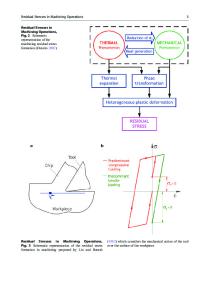Residual Stresses in Silicon Nitride Based Composites Using Synchrotron Radiation
- PDF / 63,712 Bytes
- 6 Pages / 612 x 792 pts (letter) Page_size
- 45 Downloads / 334 Views
RESIDUAL STRESSES IN SILICON NITRIDE BASED COMPOSITES USING SYNCHROTRON RADIATION Myungae Lee1, Yanan Xiao1, Dale E. Wittmer1, Susan M. Mini2, and Timothy J. Graber3 1 Department of Mechanical Engineering and Energy Processes, Southern Illinois University at Carbondale, Carbondale, IL 62901 2 Department of Physics, Northern Illinois University, De Kalb, IL 60115 and Material Science Division, Argonne National Laboratory, Argonne, IL 60439 3 The Center for Advanced Radiation Sources, The University of Chicago, Argonne, IL 60439 ABSTRACT In order to measure the residual strain (stress) in the silicon nitride based composites, synchrotron based x-ray diffraction was employed on the BESSRC beamline at the APS. The residual stress for both the baseline Si3N4 and the Si3N4-TiN composites were determined from the (441) and (531) reflections, obtained by applying the three-dimensional 2θ-sin2ψ method. In both the baseline Si3N4 and the Si3N4-TiN composites, after thermal shocking, compressive residual stresses were developed in both directions parallel and perpendicular to the specimen’s surface. The average residual stresses in the direction parallel to the sample surface were much higher than in the perpendicular direction. The measured residual stresses were compared with the flexural strength and fracture toughness results to determine the effects of residual stress and thermal shocking on the strength and toughness of each composite. The results suggested that there should be a maximum thermal shock temperature, within the range of 1000 °C to 1100 °C, for improving the fracture toughness for both the baseline Si3N4 and the Si3N4-TiN composites. Also, the addition of the TiN appeared to improve both the strength and toughness of the baseline composition. INTRODUCTION Since ceramic materials are brittle and have a high surface sensitivity, it is very important to control the fracture behavior in order to design high quality materials. Some damage on the surface of this brittle material caused by fabrication processing and machining are in the form of residual stresses and cracks in the surface and just below the surface. Even in the ceramic matrix composites, toughened by the addition of the second phase into ceramic matrix to get better mechanical properties and reliability, the residual stress exists due to the thermal expansion mismatch.[1] These residual stresses can lead to crack initiation in the sense of microcracking, influence crack propagation, and contribute to the effectiveness of crack bridging.[2] Therefore, understanding the role of interfacial and bulk residual stress on strength, toughness, and fatigue may improve processing and hence the physical and mechanical properties of ceramics and ceramic matrix composites. X-ray diffraction technique has been used extensively to determine the residual stress in polycrystalline materials. However, many diffraction profiles in ceramics, by applying radiation from different conventional x-ray tubes, appear either with over-lapping between neighboring planes or with
Data Loading...








